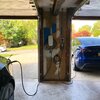So put an order in for a Model Y that will come in 6-whatever months. Also considering swapping my wife's Q5 for the upcoming Audi Q4 electric.
But can't seem to find (ie google) any EV chargers that have two cables that can be used at the same time to charge and regulate voltage to two cars?
Before I go an buy a Tesla wall charger or other EV charger, is there anything on the market that lends itself better to charging two different types of EVs and can regulate the power accordingly? Or ideally, allow the option to use more amperage on one car vs another etc?
For folks in this scenario are you running two different chargers/cabling/breakers?
But can't seem to find (ie google) any EV chargers that have two cables that can be used at the same time to charge and regulate voltage to two cars?
Before I go an buy a Tesla wall charger or other EV charger, is there anything on the market that lends itself better to charging two different types of EVs and can regulate the power accordingly? Or ideally, allow the option to use more amperage on one car vs another etc?
For folks in this scenario are you running two different chargers/cabling/breakers?



